There are 14 species of snakes in Massachusetts, two of which are venomous. However, you would rarely run into them since they mostly stick to hiding in their habitats and are quite timid.
There are no other venomous snakes native to Massachusetts other than the Timber Rattlesnake and Northern Copperhead.
In the state of Massachusetts, residents do not require a permit to own a non-venomous snake. All venomous snakes require a permit to keep as a pet.
There is a specific list of what you can and cannot keep as a pet in Massachusetts, depending on their conservation status as well as whether or not they are venomous.
According to the Massachusetts Division of Fishery and Wildlife, you may keep any venomous or poisonous snakes, any Anaconda species, the African Rock Python, Reticulated Python, Black Rat Snakes, and the Eastern Hognose.
Generally, it is illegal to release or transport any wild animal in the state. However, it is not illegal to kill any common snakes in the area; people just don’t really have reason to.
Table of Contents
Common Snakes in Massachusetts
Here are some common snakes that roam the state:
1. Black Rat Snake
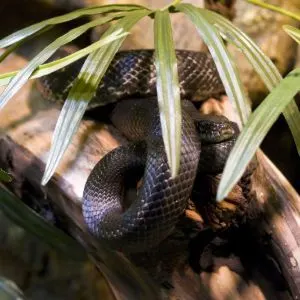
- Experience Level: Intermediate
- Family: Colubridae
- Scientific Name: Pantherophis obsoletus
- Other Names: Western Rat Snake, Black Ratsnake, Pilot Black Snake, Black Snake
- Adult Size: 3 to 6 feet
- Lifespan: 6 to 8 years
Black Rat Snakes are large snakes, growing up to 6 feet long. They are also the most popular type of Rat Snake to keep in America due to their docile nature, hefty size, and ability to help with rodent control.
As their name suggests, they are primarily black in color and may have faint white bands in between their scales. They usually have a white underside starting from their chins downward.
Hobbyists love these interesting creatures for their ability to help with pest control. They are called Rat Snakes, meaning they can be useful in helping you get rid of an overpopulation of rodents in your home, if needed.
This is why they are beneficial and sometimes kept by farmers.
They can be found in mountainous regions, rocky hillsides, or flat farmlands. They survive at various elevations and are actually proficient climbers, making homes in tree cavities that used to be the homes of other animals.
They consume rodents, amphibians, lizards, and also bird eggs.
These guys are considered the largest snakes in Massachusetts, measuring up to six feet long, some individuals even being as long as 8 feet.
They are considered an endangered species in Massachusetts, meaning they are protected under the state’s Endangered Species Act, making it illegal to kill, keep, or harass this species in any way.
2. DeKay’s Brownsnake
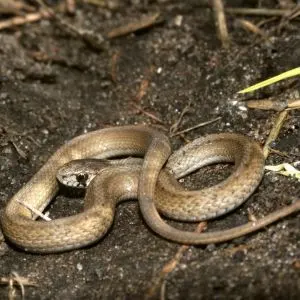
- Experience Level: Beginner
- Family: Colubridae
- Scientific Name: Storeria dekayi
- Other Names: Brown Snake, DeKay’s Brown Snake
- Adult Size: approximately 13 inches
- Lifespan: 7 years in captivity; unknown in the wild
Brownsnakes are not shy and humans commonly encounter them. They can make great pets for beginners due to their size and gentle nature. They are also quite easy to feed.
These non-venomous snakes are usually brown in color, as their name suggests, but can also come in a yellowish, red, or grayish-brown tone.
They will typically have two rows of either darker or lighter spots which might also be linked, making it look like a collar or middorsal streak down the side of their head. Underneath each of their eyes may also be a small, dark spot.
These markings may also not appear on some individuals.
Their undersides will either be white or tan.
They like to reside in various woodlands, more commonly in wet areas like swamp edges or wetland borders. They like to roam the litters of abandoned fields, lowland hardwoods, prairies, and oak savannas.
They are also often spotted in residential areas or urbanized territories.
In their habitats, they will consume small invertebrates like earthworms, slugs, and snails with their specialized jaws and teeth. They may also eat beetles and salamanders if they come across one.
In Massachusetts, they can be spotted in both urban and suburban areas where lots of slugs are. They are a little skittish, especially in the wild, so do be cautious not to startle one if you come across it.
3. Eastern Garter Snake

- Experience Level: Beginner
- Family: Colubridae
- Scientific Name: Thamnophis Cyrtopsis ocellatus
- Other Names: Garter Snake
- Adult Size: 18 to 26 inches long
- Lifespan: 10 years
Eastern Garter Snakes are relatively small and remain active during the day. They like to soak often, especially around their shedding period so they should always have a soaking bowl readily available in their tank.
They are actually one of the most commonly spotted species of snake in Massachusetts and they like to sneak into gardens.
Garter snakes are docile and will not grow to be too large, making them a very beginner-friendly reptile. If threatened, they will release a musk in order to ward off predators.
These snakes can range from dark olive-green to brown or black with a distinctive yellow or off-white stripe running throughout the length of their body.
Subspecies of Garter Snakes all look very similar so the only way to identify an Eastern is by checking their stripes. Looking at their scale patterns and counting the number of scales on their upper lip can also help you identify the type of Garter Snake as well.
In the wild, they can be found in many places like marshes, woodlands, meadows, or hillsides.
These snakes feed on leeches, slugs, worms, small fish, amphibians, and even other snakes. They are also immune to toxic frogs that secrete toxins from their skin in order to drive away prey.
4. Black Racer
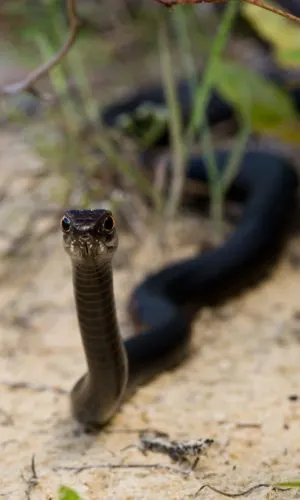
- Experience Level: Intermediate
- Family: Colubridae
- Scientific Name: Coluber constrictor constrictor
- Other Names: Northern Black Racer
- Adult Size: 33 to 65 inches
- Lifespan: 10 years
Although Black Racers are non-venomous, they are sometimes a little bit aggressive when defensive. As long as you don’t startle or corner it, it will not deliberately try to attack you.
They can grow fairly large and will raise their head when threatened before striking.
Black racers do not usually feel threatened by humans but you should still not give it a reason to use self-defense. A bite can still be painful and susceptible to infection regardless of whether or not there is venom.
As far as these snakes go as pets, they are not particularly docile and will only rarely become accustomed to being handled. Black racers also like to travel a lot over long distances, making them unsuitable for a tank or terrarium habitat.
Northern Black Racers have large, long, slender, solid black, round bodies with a white chin and a faded blue underside. They have smooth, matte-looking scales and a head that is almost the same width as their body.
Some black racers may be blue-gray, brown, dark gray, or rust-colored with blotches on their back as well.
You can find these snakes in habitats that are brushy such as grasslands, old fields, rock ledges, ridges, and agricultural fields.
They prey on toads, frogs, small birds, rodents, and smaller snakes. They may also sometimes feed on insects and invertebrates like moth larvae or butterflies.
5. Eastern Hognose Snake
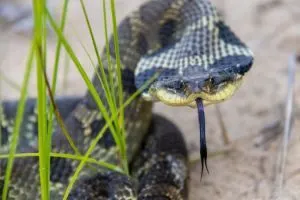
- Experience Level: Beginner
- Family: Colubridae
- Scientific Name: Heterodon platirhinos
- Other Names: Eastern hog-nosed snake
- Adult Size: 20 to 33 inches
- Lifespan: 12 years
The Hognose snake is known to be one of the best pet snakes for enthusiasts since they are not fussy and are comfortable with human interaction. They also stay relatively small.
These worm-like snakes have a large, round head with an upward-facing snout, which is what we all love about them. They are dark gray or olive-green, but some are also yellow, tan, or light brown with dark brown spotted patterns on their head and sometimes their bodies.
They also have keeled scales and may flatten their head when threatened similar to a cobra or play dead as a defense mechanism.
They prefer to inhabit sandy woodlands, farmland, coastal areas, and fields where they feed on frogs, toads, salamanders, invertebrates, birds, and small mammals. They can use their hog-like nose to get into their prey’s burrows more easily.
6. Eastern Milk Snake
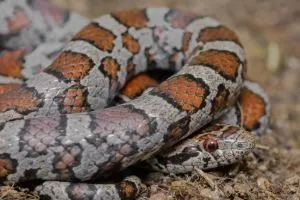
- Experience Level: Beginner
- Family: Colubridae
- Scientific Name: Lampropeltis triangulum triangulum
- Other Names: Milk Snake
- Adult Size: About 4 feet
- Lifespan: 22 years
Eastern Milk Snakes are a species of Kingsnake that are non-venomous, friendly, docile, and beautiful to look at.
Eastern Milksnakes are tan or brown with black-brown bands and blotches that loop around the length of their body. Their skin can sometimes be a pale yellow with almost a red striped pattern, similar to the Western Milk Snake and the venomous Coral snake or a Rattlesnake, depending on the Milk Snake.
They have cat-like pupils that can look intimidating but lack the rattle at the end of their tails.
They can be found in meadows, pastures, under any artificial cover, by the edges of watercourses, by mountain cliffs, and woodlands. These carnivorous snakes feed on lizards, reptile eggs, birds and their eggs, mice, and sometimes insects.
7. Eastern Ribbon Snakes
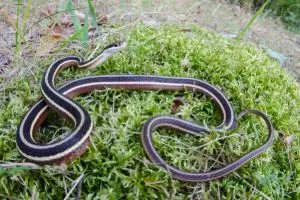
- Experience Level: Beginner
- Family: Colubridae
- Scientific Name: Thamnophis sauritus
- Other Names: Ribbon Snake
- Adult Size: 16 to 35 inches
- Lifespan: 10+ years in captivity; wild lifespan unknown
Ribbonsnakes are the most common species of Garter Snakes there are. These shy, non-poisonous snakes make popular pets due to their many morph options and the fact that they are not dangerous to keep.
Eastern Ribbonsnakes are the best tempered out of all the subspecies of Ribbonsnakes and can make good pets for novice snake keepers when bought from a reputable pet store where they are captive-bred, of course.
Ribbonsnakes are usually slender-bodied, tan or dark brown with prominent light-colored stripes throughout their length which is usually a bright or pale yellow.
Eastern Ribbonsnakes are semi-aquatic creatures and can be found mostly near a water source like the shorelines of rivers or lakes. They will sometimes inhabit water edges near forests or wetlands.
They are carnivorous and feed on small fish, insects, and tadpoles.
8. Eastern Worm Snake
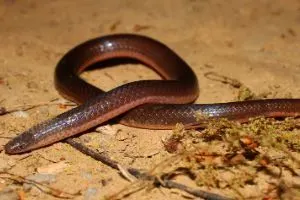
- Experience Level: Intermediate
- Family: Colubridae
- Scientific Name: Carphophis amoenus amoenus
- Other Names: Wormsnake
- Adult Size: 7 to 11 inches
- Lifespan: 4 years
In general, worm snakes are not ideal pets because of their timidness. They like to remain hidden in their substrate, which can make it hard to keep track of their health.
These shy reptiles dislike being handled and will wiggle around in your hand. You may also feel them press against you with a bit of a strong force.
Eastern Worm Snakes are shiny, scaley, and light pink or brown with a pointy tail. The color of their body can range from a light to darker brown and may have pink or white undersides, similar to a worm.
You can find these snakes in habitats that are damp or near woodlands such as hilly woodlands or farmlands nearby. They prefer grassy or wooded hillsides near streams of water.
During dry periods, they will burrow down underground where the soil is moist in order to get the dampness they need to survive.
These worm snakes eat exclusively earthworms, swallowing them completely alive. This makes it easy for them to fall prey to other animals that eat earthworms.
Although it is rare, they might also sometimes eat insect larvae or slugs.
Eastern Worm Snakes are a threatened species in Massachusetts, meaning that they are protected under the Endangered Species Act, making it illegal to kill, keep, or harass this snake in any way.
9. Northern Red-Bellied Snake
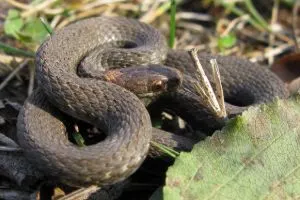
- Experience Level: Intermediate
- Family: Colubridae
- Scientific Name: Storeria occipitomaculata
- Other Names: Redbelly snake, Red-belly Snake, Copperbelly Snake
- Adult Size: 8 to 16 inches
- Lifespan: 4 years in captivity; Wild lifespan unknown but predicted to be longer than in captivity
These small snakes can be found in swarms basking in the sun on the warm days of September to October. You can also find them in woodlands, fields, under logs, in forests, bike trails, back roads, and sphagnum bogs.
In these areas, they feed on earthworms, beetle larvae, and slugs.
People can sometimes find them out in their pesticide-free garden or just out in the wild and might want to keep them as a pet. However, they really struggle to eat when in captivity and will sometimes just outright refuse when they are removed from the wild.
They do not do well in captivity and prefer to be free to roam the lands as they please. Although they aren’t hard to obtain in the wild, they might not be the best pet to keep if you are planning to have it for long since they do not do well away from their natural habitat.
Due to this, you might not run into them as often in the wild since they like to stick to their spaces. They are not as tolerant to populated areas.
It’s not hard to identify these snakes since they really do live up to their name with their flashy red or orange undersides. Their bodies might be a dark steel grey, black with a blue tint, or copper brown. Some may also have two dark stripes along their sides or a thick, light-colored band down the middle of their backs.
While they will usually first curl their tails or flee in defense before they try to bite, their little nibble probably won’t affect you anyway.
While they are small and beautiful, this does not mean they will make a good pet since they do not usually survive long in captivity.
10. Northern Water Snake

- Experience Level: Beginner
- Family: Colubridae
- Scientific Name: Nerodia sipedon sipedon
- Other Names: Watersnake, Northern Watersnake
- Adult Size: 24 to 55 inches
- Lifespan: 9 years
Northern Water Snakes are popular pets since they do not require much effort and are relatively safe, even around children. They can also grow fairly large in size.
They are usually dark in color, ranging from brown, tan, to gray, and have keeled scales. They also have square blotches on their backs and sides that may alternate or become bands throughout their length.
Water Snakes typically live in or near aquatic habitats which is why they are called water snakes. They like to bask on rocks by still or slow-moving water such as seasonal pools, lakes, and ponds.
You might see them swimming and hunting the waters as well.
They like to eat fish and amphibians, swallowing them whole and alive. They eat all kinds of fish species such as smallmouth bass, minnows, bullhead catfish, hogsuckers, sunfish, and brook trout.
11. Ringneck
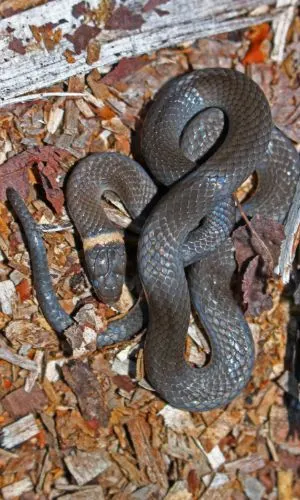
- Experience Level: Intermediate
- Family: Colubridae
- Scientific Name: Diadophis punctatus
- Other Names: Ring-necked Snake
- Adult Size: 10 to 15 inches
- Lifespan: 20 years in the wild; 6 years in captivity
Ringneck Snakes have slender bodies and smooth scales, ranging from black, bluish-black, greenish-gray, to olive in color. Their undersides will usually be yellow, orange, or red with a ring around their neck of the same color.
You can find these snakes in wide varieties of habitats as long as there is a lot of places for them to hide and take cover. They like making dens under woody debris.
They mainly feed on terrestrial worms, mollusks, and amphibians.
12. Smooth Green Snake
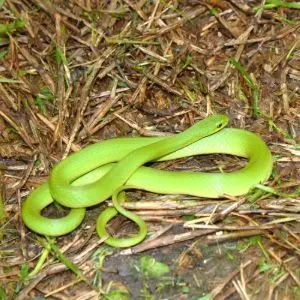
- Experience Level: Intermediate
- Family: Colubridae
- Scientific Name: Opheodrys vernalis
- Other Names: Green Snake
- Adult Size: 14 to 20 inches
- Lifespan: 6 years
Smooth Green snakes can make great pets for any owner that is a little squeamish about feeding them dead rodents. These guys will mostly eat insects like spiders, moths, ants, snails, slugs, worms, and spineless caterpillars.
However, it is said that they do not make great pets since they are way too timid for human interaction. However, they are harmless and some enjoy being handled.
They can be found in open woods, stream edges, marshes, and meadows. They thrive in moist, grassy areas. They prefer a lot of foliage to blend into.
As you can already tell by their name, these snakes will be a bright green, which can range in shade. They stay relatively small and may have a pale yellow underside with beady eyes.
These are not the easiest snakes to keep captive since they are very anxious and easily stressed out.
Venomous Snake Species in Massachussetts
Here is a list of the most venomous snakes that roam the state:
13. Timber Rattlesnake
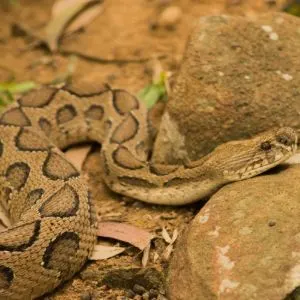
- Experience Level: Expert
- Family: Viperidae
- Scientific Name: Crotalus horridus
- Other Names: Canebrake Rattlesnake, Banded Rattlesnake
- Adult Size: 6 feet
- Lifespan: Anywhere from 10 to 30 years in the wild; 30+ years in captivity
Rattlesnake bites are no joke and should be treated as a medical emergency. They are venomous, which can mean a bite from them will be very dangerous, and in some cases, even fatal if left untreated.
These vipers are usually gray or yellow-brown in color with dark brown blotches all or bands throughout their body and a brown, yellow, or copper stripe running down the length of their back.
They can generally be found in bluffs, croplands, rugged deciduous forest terrains, rocky ledges, and dense woodlands with closed canopies. They like to move around during different seasons and females will move to rocky terrains when they are pregnant for higher temperatures.
Timber Rattlesnakes feed mainly on smaller mammals but will also eat the occasional bird if they feel like it.
These are endangered in Massachusetts and are protected under the Massachusetts Endangered Species Act, making it illegal to kill, keep, and harass this animal in any way.
14. Copperhead
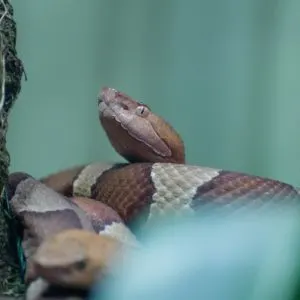
- Experience Level: Expert
- Family: Viperidae
- Scientific Name: Agkistrodon contortrix
- Other Names: Eastern Copperhead, Copperhead Snake
- Adult Size: average 2 to 3 feet; up to 4 feet
- Lifespan: 18 years
Copperheads aren’t aggressive towards humans unless provoked, which is why bites from them are somewhat rare, even in areas that they have been spotted.
These large snakes are tan in color with copper or rusty-looking, chestnut, blotches all throughout their bodies which look like spilled coffee spots. These pit vipers have a distinctively triangular-shaped head.
They can be found in a variety of environments anywhere from semiaquatic to terrestrial. This includes wetlands, hillside forests, rocky areas, and abandoned construction sites in the suburbs where they can find rotting wood or piles of sawdust.
These snakes are carnivorous, eating mostly small rodents like mice. They also consume other smaller snakes, lizards, insects, amphibians, and birds.
They do their hunting by ambushing their prey, injecting them with venom, then swallowing it whole.
This species is considered endangered in Massachusetts and is protected under the Massachusetts Endangered Species Act, making it illegal to kill, keep, and harass this animal in any way.
Conclusion
That wraps it up for the 14 snakes in Massachusetts. If you’re from the state and didn’t know what snakes roamed in the wilderness around you, we hope you found out what you needed to know.
There are many great species of snakes in the state that can make great pets and now that you know the laws, maybe we gave you some idea of which species might work best for you.
Leave us a comment below about what you think about these slithery, beautiful beings and say “hey” if you’re from Massachusetts!
Snakes in other states
